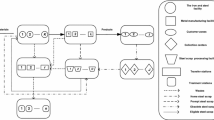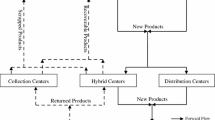Abstract
Closed-loop logistics planning is an important tactic for the achievement of sustainable development. However, the correlation among the demand, recovery, and landfilling makes the estimation of their rates uncertain and difficult. Although the fuzzy numbers can present such kinds of overlapping phenomena, the conventional method of defuzzification using level-cut methods could result in the loss of information. To retain complete information, the possibilistic approach is adopted to obtain the possibilistic mean and mean square imprecision index (MSII) of the shortage and surplus for uncertain factors. By applying the possibilistic approach, a multi-objective, closed-loop logistics model considering shortage and surplus is formulated. The two objectives are to reduce both the total cost and the root MSII. Then, a non-dominated solution can be obtained to support decisions with lower perturbation and cost. Also, the information on prediction interval can be obtained from the possibilistic mean and root MSII to support the decisions in the uncertain environment. This problem is non-deterministic polynomial-time hard, so a new algorithm based on the spanning tree-based genetic algorithm has been developed. Numerical experiments have shown that the proposed algorithm can yield comparatively efficient and accurate results.
Similar content being viewed by others
References
Abuali, F. N., Wainwright, R. L., & Schoenefeld, D. A. (1995). Determinant factorization: A new encoding scheme for spanning trees applied to the probabilistic minimum spanning tree problem. In L. J. Eshelman (Ed.), Proceedings of the sixth international conference on genetic algorithms (pp. 470–477). San Mateo, CA: Morgan Kaufmann.
Arumugam M. S., Rao M. V. C., Palaniappan R. (2005) New hybrid genetic operators for real coded genetic algorithm to compute optimal control of a class of hybrid systems. Applied Soft Computing 6(1): 38–52
Baumgarten, H., Christian, B., Annerous, F., & Thomas, S.-D. (2003). Supply chain management and reverse logistics-integration of reverse logistics processes into supply chain management approaches. In International symposium on electronics and the environment (pp. 79–83).
Biehl M., Prater E., Realff M. J. (2007) Assessing performance and uncertainly in developing carpet reverse logistics systems. Computers & Operations Research 34(2): 443–463
Carlsson C., Fullér R. (2001) On possibilistic mean value and variance of fuzzy numbers. Fuzzy Sets and Systems 122(2): 315–326
Chang W.-D. (2006) An improved real-coded genetic algorithm for parameters estimation of nonlinear systems. Mechanical Systems and Signal Processing 20(1): 236–246
Chou H., Premkumar G., Chu C. H. (2001) Genetic algorithm for communications network design—an empirical study for the factors that influence performance. IEEE Transactions on Evolutionary Computation 5(3): 236–249
De Groot M. H. (1970) Optimal statistical decisions. McGraw-Hill, New York, NY
Deep K., Thakur M. (2007) A new mutation operator for real coded genetic algorithms. Applied Mathematics and Computation 193(1): 211–230
Dubois D., Prade H. (1987) The mean value of a fuzzy number. Fuzzy Sets and Systems 24(3): 279–300
Duenas A., Petrovic D. (2008) Multi-objective genetic algorithm for single machine scheduling problem under fuzziness. Fuzzy Optimization and Decision Making 7(1): 87–104
Fleischmann M., Krikke H. R., Dekker R., Flapper S. D. P. (2000) A classification of logistics networks for product recovery. Omega 28(6): 653–666
Gen M., Cheng R. (1997) Genetic algorithms and engineering design. Wiley, New York, NY
Goetschel R., Voxman W. (1986) Elementary fuzzy calculus. Fuzzy Sets and Systems 18(1): 31–43
Hsu H.-W., Wang H.-F. (2009) Modeling of green supply logistics. In: Wang H.-F. (eds) Web-based green products life cycle management systems: Reverse supply chain utilization. IGI Global Publication, USA, pp 268–282
Jo J.-B., Yinzhen L., Gen M. (2007) Nonlinear fixed charge transportation problem by spanning tree-based genetic algorithm. Computers & Industrial Engineering 53(2): 290–298
Ke H., Liu B. (2007) Project scheduling problem with mixed uncertainty of randomness and fuzziness. European Journal of Operational Research 183(1): 135–147
Kongar, E. (2004). Performance measurement for supply chain management and evaluation criteria determination for reverse supply chain management. In Proceedings of SPIE: Environmentally conscious manufacturing IV, 5583 (pp. 106–117).
Kumar S., Naresh R. (2007) Efficient real coded genetic algorithm to solve the non-convex hydrothermal scheduling problem. Electrical Power and Energy Systems 29(10): 738–747
Listes O. (2007) A genetic stochastic model for supply-and-return network design. Computers & Operations Research 34(2): 417–442
López-González E., Rodríguez-Fernández M. A., Mendaña-Cuervo C. (2000) The logistic decision making in management accounting with genetic algorithms and fuzzy sets. Mathware & Soft Computing 7: 229–241
Lu, Q., Christina, V., Stuart, J. A., & Rich, T. (2000). A practical framework for the reverse supply chain. In International symposium on electronics and the environment (pp. 266–271).
Peng J., Liu B. (2004) Parallel machine scheduling models with fuzzy processing times. Information Sciences 166(1–4): 49–66
Salema M. I. G., Barbosa-Povoa A. P., Novais A. Q. (2007) An optimization model for the design of a capacitated multi-product reverse logistics network with uncertainty. European Journal of Operational Research 179(3): 1063–1077
Schultmann F., Zumkeller M., Rentz O. (2006) Modeling reverse logistic tasks within closed-loop supply chains: An example from the automotive industry. European Journal of Operational Research 171(3): 1033–1050
Syarif A., Yun Y. S., Gen M. (2002) Study on multi-stage logistic chain network: A spanning tree-based genetic algorithm approach. Computers & Industrial Engineering 43(1–2): 299–314
Wang H.-F., Hsu H.-W. (2010a) A closed-loop logistic model with a spanning-tree based genetic algorithm. Computers & Operations Research 37(2): 376–389
Wang H.-F., Hsu H.-W. (2010b) Resolution of an uncertain closed-loop logistics model: An application to fuzzy linear programs with risk analysis. Journal of Environmental Management 91(11): 2148–2162
Wen M., Iwamura K. (2008) Fuzzy facility location-allocation problem under the Hurwicz criterion. European Journal of Operational Research 184(2): 627–635
Yang L., Ji X., Gao Z., Li K. (2007) Logistics distribution centers location problem and algorithm under fuzzy environment. Journal of Computational and Applied Mathematics 208(2): 303–315
Yao M.-J., Hsu H.-W. (2009) A new spanning tree-based genetic algorithm for the design of multi-stage supply chain network with nonlinear transportation costs. Optimization and Engineering 10(2): 219–237
Yeh W.-C. (2005) A hybrid heuristic algorithm for the multistage supply chain network problem. International Journal of Advanced Manufacturing Technology 26(5–6): 675–685
Zadeh L. (1975) The concept of a linguistic variable and its application to approximate reasoning. Information Sciences 8(3): 199–249
Zheng Y., Liu B. (2006) Fuzzy vehicle routing model with credibility measure and its hybrid intelligent algorithm. Applied Mathematics and Computation 176(2): 673–683
Zikopoulos C., Tagaras G. (2007) Impact of uncertainty in the quality of returns on the profitability of a single-period refurbishing operation. European Journal of Operational Research 182(1): 205–225
Author information
Authors and Affiliations
Corresponding author
Rights and permissions
About this article
Cite this article
Wang, HF., Hsu, HW. A possibilistic approach to the modeling and resolution of uncertain closed-loop logistics. Fuzzy Optim Decis Making 11, 177–208 (2012). https://doi.org/10.1007/s10700-012-9120-2
Received:
Accepted:
Published:
Issue Date:
DOI: https://doi.org/10.1007/s10700-012-9120-2




